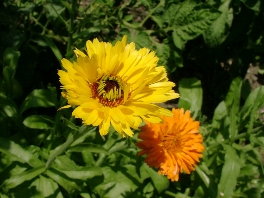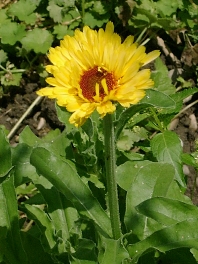 The marigold is not only a herbal remedy but is also a very nice flower in gardens.
From june on lots of farmers gardens in europe are shining from the brightness of the marigold.
The marigold is not only a herbal remedy but is also a very nice flower in gardens.
From june on lots of farmers gardens in europe are shining from the brightness of the marigold.
The flowers of the marigold are a good remedy against skin problems.
Therefore the marigold ointment is famous.
Medicinal Uses
- Gall complaints
- Stomach and intestinal disorder
- Menstrual complaints
- Skin illnesses
- Ulcers
- Contusions
- Wounds that heal badly
- Eczemas
- Bruises
- Effusion of blood
- Strain
- Sore baby skin
- Varicose veins
Information
| Used Parts: | Flowers |
| Substances: | Alkaloid, bitter essence, carotenoid, Tannic acid, resin, inulin, Kaempferol, Myristic-acid, essential oil |
| Time to collect: | June - October |
Methods

External use
Marigold is mainly used for external use.You can apply it as a poultice from the tea or you can use an ointment.
It helps against:
- Skin illnesses
- Ulcers
- Contusions
- Wounds that heal badly
- Eczemas
- Bruises
- Effusion of blood
- Strain
- Sore baby skin
- Varicose veins
Internal use
Marigold is also helpful when you drink it as a tea or use a tincture.It helps against:
- Stomach and intestinal disorder
- Gall complaints
- Menstrual complaints
Plant description
 Marigold doesn't grow wild in Europe or North America.
But it is very easy to grow in gardens.
Marigold doesn't grow wild in Europe or North America.
But it is very easy to grow in gardens.
Marigold lives for one year. It becomes up to 60 cm (2 feet) high.
The stalk, that is light green, has a lot of branches if it has enough place.
The leaves are hairy and like a round lancette.
The Flowers blossom from june until autumn. They have yellow and orange colors that shine very strong.
All the plant is full of resin.
